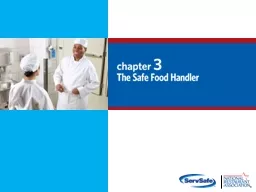

Food handlers can contaminate food when they Have a foodborne illness Have wounds that contain a pathogen Have contact with a person who is sick Touch anything that may contaminate their hands and ID: 247581
Download Presentation The PPT/PDF document "How Food Handlers Can Contaminate Food" is the property of its rightful owner. Permission is granted to download and print the materials on this web site for personal, non-commercial use only, and to display it on your personal computer provided you do not modify the materials and that you retain all copyright notices contained in the materials. By downloading content from our website, you accept the terms of this agreement.
Slide1Slide2
How Food Handlers Can Contaminate Food
Food handlers can contaminate food when they:Have a foodborne illness Have wounds that contain a pathogen_____________________________________Have contact with a person who is sickTouch anything that may contaminate their hands and do not wash themHave symptoms such as ________________, vomiting, or __________________—a yellowing of the eyes or skin
3-2Slide3
Managing a Personal Hygiene Program
Managers must focus on the following:Creating personal hygiene ___________________Training food handlers on personal hygiene policies and retraining them regularly____________________ correct behavior at all times____________________ _____food safety practicesRevising personal hygiene policies when laws or science change
3-3Slide4
Infected wounds or cuts:
Contain _____________Must be covered to prevent pathogens from contaminating food and food-contact surfacesHow a wound is covered depends on where it is located:__________________wounds on the hand or wrist with an impermeable cover, (i.e. bandage or finger cot) and then a single-use gloveCover wounds on the arm with an impermeable cover, such as a bandageCover wounds on other parts of the body with a dry, tight-fitting bandageInfected Wounds or Cuts
3-4Slide5
Single-Use Gloves
Single-use gloves:Should be used when handling ready-to-eat foodExcept when washing produceExcept when handling ready-to-eat ingredients for a dish that will be cookedMust _________________ be used in place of handwashingMust NEVER be washed and reusedMust _________ _______________________
3-5Slide6
Single-Use Gloves
How to use gloves:Wash and dry hands before putting gloves onSelect the correct glove _________________Hold gloves by the edge when putting them onOnce gloves are on, check for rips or tearsNEVER blow into gloves_______________ roll gloves to make them easier to put onTry to avoid contaminating gloves when putting them on.
3-6Slide7
Bare-Hand Contact with Ready-to-Eat Food
Bare-hand contact with ready-to-eat food must be avoided:Some jurisdictions allow it but requirePolicies on staff healthTraining in handwashing and personal hygiene practicesNEVER handle ready-to-eat food with bare hands when you primarily serve a high-risk populationFood can become contaminated when it has been handled with bare hands. This is especially true when hands have not been washed correctly or have infected cuts or wounds. For this reason, do not handle ready-to-eat food with bare hands.
3-7Slide8
Handling Staff Illnesses
You must encourage your staff to report any health problems before they come to work. This includes newly hired staff who haven’t started working yet. Staff should also let you know immediately if they get sick while working. Your regulatory authority may ask you to prove you have made staff aware of this policy.When food handlers are sick, you may need to restrict them from working with or around food. Sometimes, you may need to exclude them from working in the operation.Slide9
Handling Staff Illnesses
If:The food handler has a ________________ ______________with a feverThen:Restrict the food handler from working with or around foodExclude the food handler from the operation if you primarily serve a high-risk populationA written release from a medical practitioner is required before returning to work
3-8Slide10
Handling Staff Illnesses
3-9If:The food handler has at least one of these symptoms
__________________________________________________Then:Exclude the food handler from the operationBefore returning to work, food handlers who vomited or had diarrhea must meet one of these requirementsHave had no symptoms for at least 24 hours
Have a written release from a medical practitionerSlide11
Handling Staff Illnesses
If:The food handler has _____________________Then:Food handlers with jaundice must be reported to the regulatory authorityExclude food handlers who’ve had jaundice for less than seven days from the operationFood handlers must have a written release from a medical practitioner and approval from the regulatory authority before returning to work
3-10Slide12
If:
The food handler has been diagnosed with a foodborne illness caused by one of these pathogens and has symptoms___________________________ Salmonella TyphiEnterohemorrhagic and shiga toxin-producing E. coli
___________________________Shigella spp.Then:Exclude the food handler from the operationWork with the food handler’s medical practitioner and/or the local regulatory authority to decide when the person can go back to work
Handling Staff Illnesses
3-11